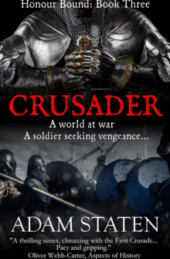Harald Hardrada is one of the characters from history who has always fascinated me. I mean, anyone who goes by the moniker ‘Hard Ruler’ must have something about them, right? For the purposes of full transparency, though, I should point out that he has an all-too-brief cameo role in the first of my Huscarl’s Chronicles trilogy – Thurkill’s Revenge – pitching up at the battle of Stamford Bridge where (spoiler alert) he meets a sticky end. So, when I was sent a copy of Don Hollway’s The Last Viking with a request that I write this review, I didn’t need asking twice.
Harald’s momentous appearance on the stage of this nation’s history came at the end of a life that was filled to the brim with violence, travel, intrigue, romance, politics and even poetry. You’d struggle to think of anyone from recent times who’d come anywhere near such a wide and varied range of accomplishments. Scratching my head about that, I thought of Bruce Dickinson after a while. The lead singer of Iron Maiden was also a fencer of international standard and a commercial pilot to boot; so that covers the travel, poetry and ‘violence’, but still leaves him some way short.
Don Hollway has done a painstakingly brilliant job of bringing Harald’s story to life in the pages of this book. And what a life! It all began when – at the age of fifteen – he fought alongside his half-brother, Olaf, the deposed king of Norway, at the battle of Stiklesad.
Following that cataclysmic defeat, in which Olaf was killed, Harald made his way to Kiev and the court of his kinsman, Prince Jaroslav. But Kiev could not hold him for long; it could not match his ambition. After three years, by which time Harald had risen to captain of the guard, he sailed down the Dnieper, arriving eventually at Constantinople (at that time, one of the foremost cities of the known world).
A good portion of the book is devoted to the decade or so that Harald spent in the then capital of the Roman Empire, many of them at the centre of court intrigue at the head of the famed Varangian Guard. It is a tale so fantastic (in its truest sense) that it is hard to believe at times. And this in turn casts a light on the issues Hollway must have faced when compiling this book: the myriad of sources and their respective reliability. More than once, the author points out where the chroniclers contradict each other, leaving him with Odin’s own job of steering a navigable course through often tempestuous waters. That he brings the ship home safely with all hands, is testament to his skill as our narrator.
The final section of the book deals with Harald’s time back in Norway and his attempts to add Denmark and Sweden to his dominions. It was in this period that he really earned his nickname; his ruthless no-holds barred approach resulted in great swathes of death and destruction, even amongst peoples already subject to his authority.
When compared to his time as a master of politics and intrigue in Constantinople, I could not help but feel that this cruel and rapacious behaviour was a little out of character. Perhaps it reflected a growing lack of patience as he grew older, a sense of frustration at being so often thwarted in his designs.
After a life filled with adventure, however, I’m sure he could not resist one last throw of the dice when Tostig Godwineson came calling in 1066 with a plan to divide up the throne of England between them. His former military prowess was on display when he sent the Earls of Mercia and Northumbria packing at Fulford Gate. But – just five days later, he seemed to allow complacency to get the better of him when he was caught totally unprepared by King Harold at Stamford Bridge. Though it was undoubtedly a great Anglo-Saxon victory, one can’t help but wonder if the result might have been different had Harald brought his whole army – fully armoured – to the party.
Harald died at the age of fifty-one, and few of his era could be said to have achieved so much in their time on earth. Indeed, it is a wonder that Hollywood has yet to come calling to transpose his story to the big screen. But were they to do so, they could do worse than read this fascinating account and to drop its author a line.
The Last Viking by Don Hollway is out now and published by Osprey.
Paul Bernardi is the author of the Huscarl trilogy, set during the Norman conquest. The latest is Thurkill’s Rebellion.







